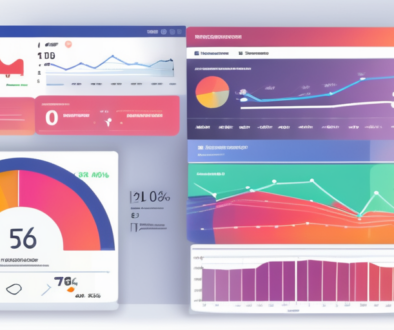Understanding Display Ads: Everything You Need to Know
Display ads are a popular form of online advertising that businesses use to promote their products or services. These ads are visually appealing and typically include images, videos, or interactive elements to capture the attention of the target audience. In this article, we will explore the concept of display ads, their various types, how they work, and the key elements of creating effective display ads. We will also discuss how to measure the success of display ads and the tools available for tracking their performance.
Understanding the Concept of Display Ads
Definition and Basic Features of Display Ads
Display ads, also known as banner ads, are graphic advertisements that appear on websites or mobile apps. They are designed to attract the attention of the audience and encourage them to take a specific action, such as clicking on the ad or making a purchase.
These ads typically consist of a visually appealing image or video, accompanied by a headline, descriptive text, and a call-to-action button. They are placed strategically on websites that attract the target audience, either through direct advertising agreements or with the help of ad networks.
Display ads come in various formats, including static banners, animated GIFs, and rich media ads that can include interactive elements such as video or audio. The flexibility of display ads allows businesses to experiment with different creative approaches to see what resonates best with their target audience.
Importance of Display Ads in Digital Marketing
Display ads play a crucial role in the field of digital marketing. They offer businesses a way to increase brand awareness, reach a wider audience, and drive traffic to their websites. Unlike search ads that appear when users actively search for specific keywords, display ads are shown to users as they browse the web, making them an excellent tool for reaching new potential customers.
Display ads also give businesses the opportunity to showcase their products or services in a visually appealing manner, capturing the attention of the audience and leaving a lasting impression. By carefully targeting their ads to relevant websites and demographics, businesses can maximize the impact of their display ad campaigns.
Moreover, display ads can be highly effective in retargeting campaigns, where ads are shown to users who have previously visited a website but did not complete a desired action, such as making a purchase. By keeping the brand top of mind for these users, display ads can help increase conversion rates and drive revenue.
Different Types of Display Ads
Banner Ads and Their Significance
Banner ads are the most common type of display ads. They are rectangular advertisements that appear at the top, bottom, or sides of a website. Banner ads are typically static images, but they can also include animations or videos. These ads are an effective way to grab the attention of the audience and convey the message quickly.
Banner ads can be further classified into standard banners, leaderboard banners, skyscraper banners, and more, depending on their size and placement on the website. Standard banners are the most common type, usually appearing at the top or bottom of a webpage. Leaderboard banners, on the other hand, are wider and shorter, often found at the top of a webpage. Skyscraper banners, as the name suggests, are tall and narrow, typically placed on the sides of a webpage. These different types of banners allow businesses to choose the most appropriate format based on their objectives and the website’s layout.
When designing a banner ad, it is crucial to consider factors such as color scheme, font choice, and imagery. The ad should be visually appealing and align with the brand’s identity. Additionally, the message should be concise and compelling, encouraging users to take action, whether it’s clicking on the ad or making a purchase.
Interstitial Ads: An Overview
Interstitial ads are full-screen ads that appear between webpages or app screens. They typically cover the entire screen, providing a highly immersive experience for the audience. Interstitial ads are effective for delivering rich media content or interactive experiences, as they engage the user’s full attention.
When using interstitial ads, it is important to strike a balance between capturing attention and respecting the user experience. Displaying too many interstitial ads can be intrusive and lead to a negative user experience, potentially driving users away from the website or app. Therefore, businesses should carefully consider the timing and frequency of interstitial ads to ensure they enhance rather than disrupt the user’s journey.
One effective strategy for interstitial ads is to use them during natural transition points, such as when a user completes a level in a game or finishes reading an article. This way, the ad becomes a seamless part of the user’s experience, providing valuable content or offers without interrupting their flow.
Rich Media Ads and Their Impact
Rich media ads are interactive display ads that go beyond static images or videos. These ads can include elements such as audio, video, animations, or even games, providing an engaging and interactive experience for the audience.
Rich media ads are particularly effective in capturing the attention of the audience and boosting brand recall. By allowing users to interact with the ad, businesses can create a memorable experience that encourages them to take action, such as clicking on the ad or exploring further. For example, a car company could create a rich media ad that allows users to virtually customize and explore different car models, creating a more immersive and personalized experience.
However, it is important to strike a balance between interactivity and load times. Rich media ads can be more resource-intensive, potentially affecting the page load speed. Therefore, businesses should optimize their rich media ads to ensure a smooth and seamless user experience.
In conclusion, display ads come in various formats, each with its own significance and impact. From banner ads that quickly grab attention to interstitial ads that provide immersive experiences, and rich media ads that engage users with interactive content, businesses have a range of options to effectively communicate their message and drive user engagement.
How Display Ads Work
The Role of Ad Networks
Ad networks play a crucial role in the distribution of display ads. These networks connect advertisers with publishers, facilitating the placement of ads on websites. Ad networks provide a platform for businesses to target specific audiences, manage their ad campaigns, and track their performance.
Working with ad networks offers businesses a myriad of benefits beyond just ad placement. These networks often provide valuable insights and data analytics to help advertisers optimize their campaigns. By leveraging the data collected from various ad placements, businesses can refine their targeting strategies and improve the effectiveness of their display ads.
When businesses decide to run a display ad campaign, they work with ad networks to identify the target audience demographics, interests, and website placements. Ad networks utilize their technology and connections to display the ads on relevant websites, ensuring maximum visibility and engagement.
Understanding Ad Auctions and Bidding
Display ads are typically sold through a bidding process, where advertisers compete for ad placements on websites. Ad auctions take place in real-time, and advertisers bid for the opportunity to display their ads to the website’s audience.
Participating in ad auctions requires a strategic approach from advertisers. Beyond just setting a bid amount, advertisers need to consider the quality of their ad creatives and the relevance of their messaging to the target audience. Ad networks often provide guidance on optimizing bids and ad content to increase the chances of winning auctions and achieving campaign objectives.
Ad auctions consider factors such as bid amount, ad relevance, and quality score to determine the winning ad. Advertisers have the option to set a maximum bid amount or use automated bidding strategies based on their objectives, budget, and target audience.
Creating Effective Display Ads
Key Elements of a Successful Display Ad
To create effective display ads, businesses need to consider several key elements. Firstly, the headline of the ad should grab the audience’s attention and clearly convey the value proposition. The descriptive text should be concise and compelling, highlighting the benefits of the product or service.
The visual element of the ad should be visually appealing, relevant to the message, and reflect the brand’s identity. Including a strong call-to-action button is crucial to encourage users to take the desired action, whether it is to make a purchase, sign up for a newsletter, or visit the website.
Moreover, it’s essential to consider the placement of the display ad. Strategic placement on websites that are frequented by the target audience can significantly impact the ad’s performance. A/B testing different placements can help determine the most effective positioning for the ad to maximize visibility and engagement.
Design Tips for Display Ads
When designing display ads, businesses should keep in mind the principles of effective visual design. The ad should have a clean and uncluttered layout, with a clear hierarchy of information. Using striking colors, high-quality images, and legible fonts can enhance the visual appeal of the ad.
It is important to ensure that the ad’s design is responsive and optimized for different devices and screen sizes. Testing different versions of the ad and optimizing based on performance data can help businesses create the most effective display ads.
In addition to visual elements, businesses should also consider the relevance of the ad content to the target audience. Tailoring the messaging to address specific pain points or desires of the audience can increase the ad’s effectiveness. Conducting market research and gathering insights about the target demographic can inform the content strategy for display ads, leading to more impactful campaigns.
Measuring the Success of Display Ads
Key Performance Indicators for Display Ads
Measuring the success of display ads is essential to evaluate the return on investment and optimize future campaigns. There are several key performance indicators (KPIs) that businesses can use to track the effectiveness of their display ad campaigns.
Impressions measure the number of times an ad is displayed to the audience, providing insights into the reach of the campaign. Click-through rate (CTR) indicates the percentage of users who click on the ad after seeing it, reflecting the ad’s relevance and appeal. Conversion rate measures the percentage of users who complete a desired action, such as making a purchase or filling out a form.
But let’s dive deeper into the world of display ads and explore some additional KPIs that can provide even more valuable insights. One such KPI is the viewability rate, which measures the percentage of ad impressions that are actually viewable by users. This helps businesses understand if their ads are being seen by their target audience or if they need to make adjustments to improve visibility.
Another important KPI is the engagement rate, which measures how users interact with the ad beyond just clicking on it. This can include actions such as watching a video, hovering over the ad for more information, or interacting with interactive elements. By tracking the engagement rate, businesses can gauge the effectiveness of their ad design and content in capturing and retaining users’ attention.
Tools for Tracking Display Ad Performance
There are various tools available to track the performance of display ads. Google Analytics is a popular platform that provides in-depth insights into the audience, ad impressions, clicks, conversions, and more. It allows businesses to monitor the performance of their display ads and make data-driven decisions to optimize their campaigns.
But Google Analytics is not the only tool in the market. Other tools like Moat, AdRoll, and SEMRush offer features for ad tracking, competitive analysis, and campaign optimization. Moat, for example, specializes in measuring viewability and ad attention metrics, providing businesses with a comprehensive understanding of how their ads are being viewed. AdRoll, on the other hand, offers advanced targeting and retargeting capabilities, allowing businesses to reach their desired audience more effectively. And SEMRush provides valuable insights into competitors’ ad strategies, helping businesses stay ahead in the ever-evolving digital advertising landscape.
With these tools at their disposal, businesses can gain a holistic view of their display ad performance and make informed decisions to improve their campaigns.
In conclusion, display ads are an essential part of digital marketing, allowing businesses to reach a broader audience and promote their products or services effectively. By understanding the concept of display ads, exploring their various types, and leveraging their potential, businesses can create compelling and impactful ad campaigns that drive results. Through careful measurement and optimization, businesses can ensure the success of their display ad campaigns and maximize their return on investment.



